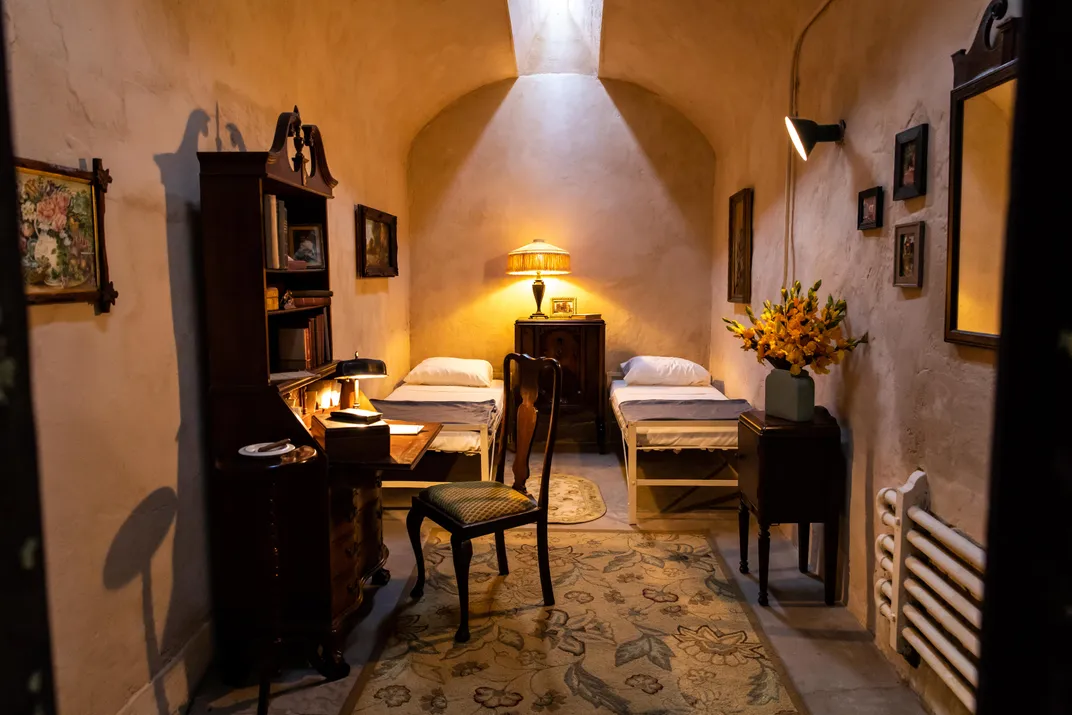Here’s What Al Capone’s Philadelphia Prison Cell Really Looked Like
The mob boss spent nine months imprisoned at Eastern State Penitentiary, and a new exhibition shows his stay was less glamorous than it was portrayed
/https://tf-cmsv2-smithsonianmag-media.s3.amazonaws.com/filer/9c/f0/9cf07dd8-85de-47d9-b6ca-fc5ae0a01839/5-2_esp_event-7977.jpg)
Years before tax evasion finally took down Al Capone, America’s most notorious gangster served time for a slightly more fitting criminal charge: carrying a concealed, unlicensed .38 caliber revolver.
Capone’s nine-month stint in Philadelphia’s Eastern State Penitentiary has long been portrayed as a cushy visit, with a 1929 newspaper article describing the “tasteful paintings” adorning his cell’s “once-grim walls,” “the glow of a desk lamp which stood on a polished desk” and the “strains of a waltz … emitted by a powerful cabinet radio receiver of handsome design and fine finish.” But new research conducted by staff at the prison-turned-museum suggests the mobster’s stay was actually more on par with that of the average inmate.
Now, Kristen de Groot writes for the Associated Press, after four months of work, Capone’s cell—reimagined to better reflect the reality of his imprisonment—has reopened to the public.

The redesign features less ostentatious furniture and an added cot for Capone’s reported roommate, an embezzler named Bill Coleman. The pair slept on cots, split a single dresser, and decorated the room with a prison-made rag rug and vase of gladiolus. A “smoking stand in the form of a butler” was the fanciest object on display, according to a rediscovered Philadelphia Record account from August 21, 1929.
“It is by no means the most luxuriously furnished cell in the prison,” the Record noted. “There are others that are more sumptuous.”
A story published in the March 8, 1930, edition of the Ottawa Citizen supports this version of events, writing, “Capone … had no better quarters than scores of other men.” By this point in time—just weeks before his release on good behavior—the gang boss and his then-cellmate had reportedly acquired an additional “few pictures on the walls,” a cheap radio and a phonograph.
The revamped Capone cell combines elements of these varying accounts, retaining a waltz-playing radio while introducing a roll of toilet paper to symbolize the gangster’s lack of privacy.
As far as curators know, the cell is not necessarily the one where Capone was detained. As Sean Kelley, the museum’s director of interpretation, explains, it’s always been unclear which of the penitentiary’s four high-profile prisoner cells Capone inhabited. Although the original recreation was housed in Cell 1 of what is known as “Park Avenue,” the new exhibit has shifted to Cell 3.
The move was largely a practical decision, according to John McDevitt of Philadelphia’s KYW Newsradio station. During initial renovations in Cell 1, workers unearthed more than 20 hidden layers of paint indicative of two distinct decorating campaigns. One, marked by a vertical brown stripe on the rear of the cell wall, may have revolved around a mural, while the other was probably focused on crafting faux wood finishing.
“They were colorful, they were decorative,” Liz Trumbull, manager of historic preservation and architectural conservation, tells McDevitt. “There was evidence of artistic painting in this cell, so we decided to pause our work and really study what we were finding."
Ultimately, the team opted to vacate Cell 1, leaving traces of the prison’s little-known artistic history accessible to visitors and researchers. Next door, an Eastern State Penitentiary press release notes, workers patched up the aging cell’s walls, lime-washed them to align with a period-appropriate color scheme, and installed a mixture of furniture—items both previously exhibited and newly acquired.
Despite reports to the contrary, prison administrators claimed that their most high-profile prisoner received no special treatment. “This man, called a gangster, comes here to me as just another prisoner,” Warden Herbert Smith told reporters shortly after Capone’s arrival. Closer to the end of the mob boss’ sentence, Smith maintained his stance, saying, “Nobody is shown any favoritism, millionaire or pauper. Capone worked hard and observed every rule, and earned his two months off for good behavior.”
Capone was released from Eastern State on March 17, 1930. Toward the end of the following year, he was found guilty of tax evasion and sentenced to 11 years in prison. Serving out seven years, six months and 15 days of this sentence at both the Atlanta federal penitentiary and Alcatraz, the gangster—reduced to the mentality of a 12-year-old by severe syphilis—retired to his Florida estate, where he died on January 25, 1947.
/https://tf-cmsv2-smithsonianmag-media.s3.amazonaws.com/accounts/headshot/mellon.png)
/https://tf-cmsv2-smithsonianmag-media.s3.amazonaws.com/accounts/headshot/mellon.png)